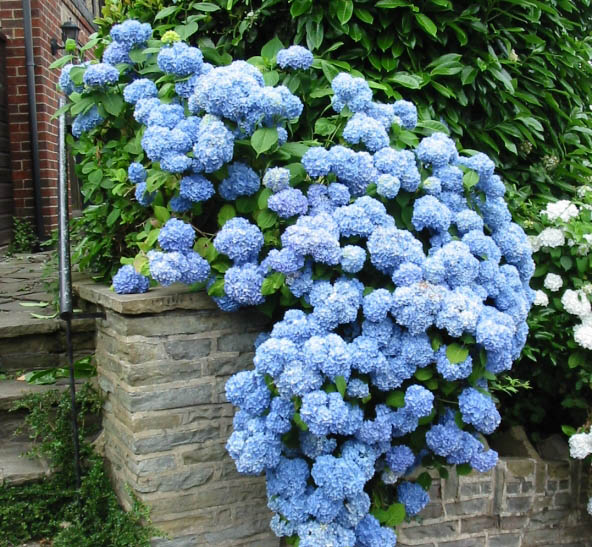Hydrangea remontant large-leaved variety forever ever together. Magical hydrangea large-leaved Nikko Blue: growing and care
Large-leaved hydrangea: frost-resistant varietiesLarge-leaved hydrangea has a huge number of excellent varieties bred by breeders of the world. In European countries, a rare garden does without these beautiful plants.
Russian gardeners relatively recently got this opportunity - to join the achievements of world selection and grow magnificent hydrangeas in their gardens.
Here is a small list of varieties of large-leaved hydrangea that are imported into Russia. These are: Alphengluhen, Aysha, Bodensee, Bouquet Rose, Blaumeise, Blue Wave, Green Shadow, Glowing Embers, Hamburg, Harlekijn, Hovaria series (Homigo, Hopaline, Mirai, Ripple), Lady in Red, Leuchtfeuer, Nikko Blue, Kardinal, Masia , Red Baron, Renate Steiniger, Pia and others.
Increasing winter hardiness of large-leaved hydrangeas
Winter hardiness is the ability of a plant to withstand a whole range of unfavorable environmental factors in winter.
In regions with warm winters, no problems arise with the cultivation and flowering of large-leaved hydrangeas. However, the colder the winter, the more troublesome it becomes for gardeners to care for this plant in order to admire the annual flowering of the bush.
The problem lies in the relatively low winter hardiness of these plants and the need to preserve the upper buds of last year's shoots in winter, where the rudiments of future inflorescences are located. These are limiting factors in using large-leaved hydrangeas to decorate gardens in areas with harsh winters, with unpredictable temperature fluctuations from severe frosts to thaws.
The main ways to increase the winter hardiness of large-leaved hydrangea are the selection of resistant plants and the selection of varieties that show the greatest adaptability to a complex of unfavorable factors in cold wintering conditions.
For example, in America there was an accidental mutation of one of the varieties of large-leaved hydrangea in a very cold winter. Which led to the emergence of frost-resistant hydrangea, which is capable of blooming both on last year's shoots and on the shoots of the current year. This amazing new variety was named “Endless Summer”.
Breeding large-leaved hydrangea
Progressive legislative acts (Laws on plant licensing and on deductions for each sold specimen to the creator of a new variety) have given a huge boost for breeders. This favorably affected the development of breeding of large-leaved hydrangeas in America, Holland and Japan.
Even more winter-hardy large-leaved hydrangea “Early Sensation” (Forever & Ever Pink / Blue /) has appeared. And it was followed by a whole series - Forever & Ever (varieties Blue Heaven, White Ball, Red Sensation, Peppermint).
Winter-hardy series of large-leaved hydrangea You & Me (You & Me Forever, You & me romance, You & Me Eternity, You & me expression, You & me together, You & Me Symphony) introduced the lovers of this plant to wonderful varieties with double flowers.
Three varieties marked in bold from this series, in addition to winter hardiness, bloom on the shoots of the past and current year. And two of them also belong to the Forever & Ever series (Forever & Ever Expression is a synonym for You & Me Expression; Forever & Ever Double Pink / Blue / is a synonym for You & Me Romance).
The large-leaved hydrangea variety “Endless Summer” for breeders served as the basis for a new series of the same name, Endless Summer, including varieties: Endless Summer Hydrangea ('Endless Summer "), Endless Summer Blashing Bride, Endless Summer Original (' Bailmer"), Endless Summer Twist-n- Shout ('PIIHM-I ", RE).
The list of varieties of winter-hardy, remontant (RE) and terry large-leaved hydrangeas is increasing. It:
Fireworks Pink (pink, RE), Fireworks White (white, lacecap, RE), Coco Blanc (white terry, RE; synonym for Double Star Coco, Triple Star Coco, You & Me Coco), Shamrock (terry, RE), David Ramsey (RE ), Oak Hill (RE), Decatur Blue (RE), Penny Mac (RE), All Summer Beauty (RE), Mini Penny (RE), H. serrata Blue Deckler (RE), Let 's Dance Starlight (RE) , Let "s Dance Moonlight ('Robert", RE), Eva Lyon Holmes (RE), Madame Emilie Mouillere (RE), etc.
A new era has begun for the large-leaved hydrangea with the advent of these chic winter-hardy varieties. And Russian flower growers can now purchase them for their garden.
The former fashion for these plants is returning, because flowering bushes Hydrangeas used to traditionally decorate Russian estates!
Common varieties of large-leaved hydrangea survive cold winters only under cover. However, early autumn or late spring frosts can damage the flower buds of the bush, and then it does not bloom.
The difference between the new varieties of large-leaved hydrangea is their ability to grow successfully and bloom regularly in gardens located in regions with frosty winters and long, cold springs.
In addition to winter hardiness, these resistant varieties have another remarkable property. They are able to bloom both on last year's shoots and on the shoots of the current year. Therefore, they are called remontant (RE) or "Always blooming" ("Everyblooming").
And if suddenly it is not possible to preserve flower buds on last year's branches of hydrangea, then new flower buds will form on the grown young shoots, and hydrangeas will certainly bloom in summer.
Large-leaved hydrangeas in our garden
Large-leaved hydrangeas “Early Sensation” have been growing in our garden for six years. And I am not overjoyed that every year I have the opportunity to see them bloom ...
Inflorescences on last year's and current shoots of these bushes were formed even after very severe frosts that occurred in the winter of 2005-2006. and in 2008-2009.
Recently, my collection has been replenished with new interesting varieties of winter-hardy large-leaved hydrangeas.
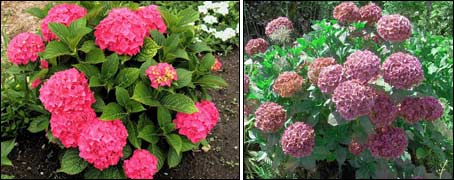
The “Red Sensation” hydrangea with burgundy branches surprises with its unusual color of flowers. At first, its inflorescences are scarlet-red with a brilliant tint, and by autumn the flowers acquire a rich color in burgundy-pastel colors.
The exquisite large-leaved hydrangea "Peppermint" has pale pink flowers with a wide white border.
The “Expression” variety flaunts large double flowers of intense pink color.
Change in color of inflorescences in large-leaved hydrangea
Like all large-leaved hydrangeas, new varieties of hydrangeas are able to change the color of their inflorescences from pink and red to bluish-blue and burgundy-purple when the acidity of the soil changes to pH 5.2-5.5.
To do this, you can use special blue dyes, they are sold in the store in the fertilizer department. Or ordinary alum is used (alum is called crystals of metal salts, which are highly soluble in water and used to give it an acidic environment).
Usually, to color hydrangea inflorescences in blue, aluminum or iron alum is used for watering and mixing into the ground, which is used for watering every week or twice a month.
To obtain the desired color of the inflorescences, I water the hydrangea bushes with a solution of aluminum sulfate. I will take a solution in the proportion: 1 tablespoon of aluminum sulfate per 5 liters of water.

To change the color of the flowers of large-leaved hydrangea, peat is also used: they bring it into the ground, mulch the hydrangea bush with peat, water the hydrangea with water infused with peat (it is also good as a fertilizer).
Rusty nails or pieces of rusty iron, thrown in the irrigation water for several days in advance, also contribute to the "blueing" of the hydrangea flowers. For long-lasting rust, nails can be buried in the ground near the roots of the hydrangea.
Growing large-leaved hydrangea
Caring for large-leaved hydrangeas during the garden season is mainly limited to regular watering in dry hot weather.
It is important for novice gardeners to know about the correct feeding of large-leaved hydrangeas. A mineral fertilizer that can be used when growing hydrangeas with blue-blue flowers should be low in phosphorus and high in potassium (NPK \u003d 25: 5: 30).
The acidity of water for irrigation should not be higher than pH 5.6.
Reproduction of large-leaved hydrangea
Large-leaved hydrangeas reproduce well by dropping their shoots into the ground in the garden, as well as by cuttings (both at home and in the garden).
For me, cutting hydrangeas at home in the winter, when I am free from gardening, is more suitable.
I plant cuttings rooted at home in the spring in the garden. Over the summer, they manage to grow up and get stronger, which allows young hydrangeas to transfer wintering to open ground when they are sheltered from frost.
What to do if hydrangea doesn't bloom? Maybe freezing? But when I bought it, they told me that it was a garden, winter-hardy hydrangea. Although for the winter I covered her like roses. How to grow hydrangea?
Elena Miloradova, St. Petersburg.
Dear friends, the issue of hydrangeas has been discussed more than once, but there will always be confusion with them.
You should be aware that there are several types of hydrangeas that can grow in open ground at the latitude of the Moscow region and St. Petersburg. All these hydrangeas can be called "garden". They differ from each other in color and shape of inflorescences, but most importantly - in winter hardiness.
The most winter-hardy types of hydrangeas are treelike and paniculate. Most of their varieties have white inflorescences, but many varieties have been created with pink (or pinkish) flowers.
Treelike and panicle hydrangeas bloom on the shoots of the current year, that is, on young growths that have grown this season. Therefore, their flowering does not depend on wintering, they bloom every year.
To obtain more powerful shoots and large inflorescences, treelike and panicle hydrangeas are cut off. By pruning, the total number of flowers is reduced, but each inflorescence blooms much larger.
The principal difference is the large-leaved hydrangea (with pink and blue flowers), photo 1. It blooms on the shoots of the last year. Moreover, flower buds are located at the tops of the shoots. Therefore, if the shoots are frozen in winter or were cut during pruning, then this hydrangea will not bloom.
Please note that varieties of large-leaved hydrangea differ greatly in winter hardiness. Among them there are those who do not hibernate in the ground, even with shelter. They are grown as houseplants... In garden centers, such varieties are often sold in the spring already with flowers. Indoor varieties can be distinguished by very large inflorescences and brighter color (photo 4).
Nearby, on the same showcase, they can stand garden varieties large-leaved hydrangea (which hibernate with shelter). In spring they are usually still small and without flowers.
![]()
Consultants in garden centers are not always competent enough to distinguish large-leaved hydrangea from paniculate and tree-like. Therefore, you could be told that the large-leaved hydrangea is a winter-hardy species. And if you bought a hydrangea at a garden fair, then there you could have deceived you at all, selling a non-resistant variety.
WHAT TO DO?
So what if the large-leaved hydrangea does not bloom?
First, don't cut it. Many people shorten the shoots, like those of roses, so that they better get away under cover. But thereby the upper buds are cut off, where the flowers are laid.
Secondly, you need to cover the hydrangea in time. In autumn - before roses, before the onset of severe frosts, and in the spring do not rush to open it (until the frost is over).
If the flower buds freeze in the spring, then there will be no flowering either, despite the fact that the bush itself wintered well.
What to do now if the hydrangea is not blooming? Keep looking after the plant and look forward to next year. For the best ripening of the shoots, feed the plant with fertilizer for hydrangeas and water it abundantly.

Do not cut off young growths before sheltering. Try to bend the branches to the ground. Then the tips will be under the snow and the flower buds will not freeze.
Cover the bush with a double layer of spunbond on top and press it with stones. additionally cover with a plastic wrap. Until stable cold weather, do not press the film from below so that airflows remain. Then lower it to the ground. Your hydrangea will probably bloom next year.
Large-leaved hydrangea varieties have been created, which bloom twice: first on the shoots of last year, then on the shoots of the current year. Even if last year's stems freeze, flowering will still take place, only later, towards the end of summer.
Such hydrangeas include varieties from the series "Endless Summer", "Together forever" (Forever & Eve), "You and me" (You and Me). Often these varieties are called winter-hardy, although we also need to cover them here.
And yet, for growing in the Middle Lane, you need to choose these particular hydrangeas. In frosty winter, flowering will be on the shoots of the current year, and she will delight with lush hats.
The blue varieties are especially good. For purity of color, they are maintained with special fertilizers for blue hydrangeas. Do this several times per season, starting in early spring, then the color will not go pink.
Large-leaved hydrangea has a huge number of excellent varieties bred by breeders of the world. In European countries, a rare garden does without these beautiful plants.
Russian gardeners relatively recently got this opportunity - to join the achievements of world selection and grow magnificent hydrangeas in their gardens.
"You & Me"
A small list of varieties of large-leaved hydrangea that are imported into Russia: "Alphengluhen", "Ayesha", "Bodensee", "Bouquet Rose", "Blaumeise", "Blue Wave", "Green Shadow", "Glowing Embers", "Hamburg, Harlekijn ", Hovaria series (" Homigo "," Hopaline "," Mirai "," Ripple ")," Lady in Red "," Leuchtfeuer "," Nikko Blue "," Kardinal "," Masia "," Red Baron " , "Renate Steiniger", "Pia" and others.
Increasing winter hardiness of large-leaved hydrangeas
Winter hardiness is the ability of a plant to withstand a whole range of unfavorable environmental factors in winter. In regions with warm winters, no problems arise with the cultivation and flowering of large-leaved hydrangeas. However, the colder the winter, the more troublesome it becomes for gardeners to care for this plant in order to admire the annual flowering of the bush.
 "Endless-Summer blue" ("Bailmer")
"Endless-Summer blue" ("Bailmer")
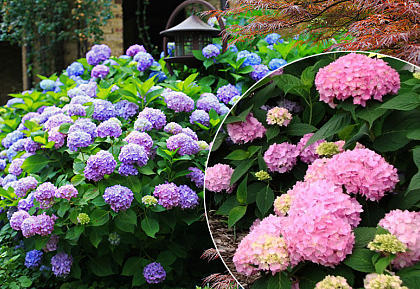 "Endless-Summer pink"
"Endless-Summer pink"
The main ways to increase the winter hardiness of large-leaved hydrangea are the selection of resistant plants and the selection of varieties that show the greatest adaptability to a complex of unfavorable factors in cold wintering conditions.
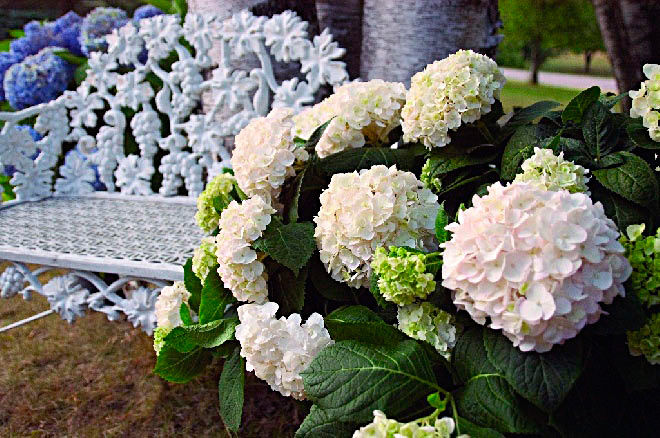 "Endless-Summer The Bride"
"Endless-Summer The Bride"
For example, in America there was an accidental mutation of one of the varieties of large-leaved hydrangea in a very cold winter. Which led to the emergence of frost-resistant hydrangea, which is capable of blooming both on last year's shoots and on the shoots of the current year. This amazing new variety has been named "Endless Summer".
Breeding large-leaved hydrangea
Progressive legislative acts (Laws on plant licensing and on deductions for each sold specimen to the creator of a new variety) have given a huge boost for breeders. This favorably affected the development of breeding of large-leaved hydrangeas in America, Holland and Japan.
Even more winter-hardy large-leaved hydrangea "Early Sensation" (Forever & Ever Pink, Forever & Ever Blue) has appeared. And it was followed by a whole series - Forever & Ever (varieties "Blue Heaven", "White Ball", "Red Sensation", "Peppermint").
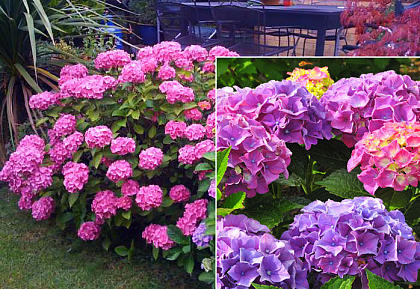 "Forever and Ever pink"
"Forever and Ever pink"
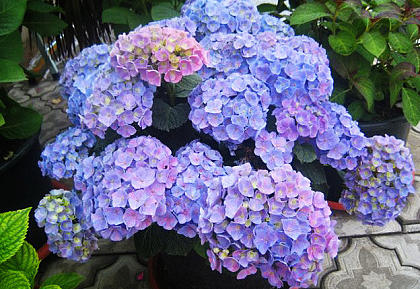 "Forever and ever blue"
"Forever and ever blue"
The large-leaved hydrangea variety "Endless Summer" for breeders served as the basis for a new series of the same name, Endless Summer, which includes varieties: "Endless Summer Pink", "Endless Summer Blashing Bride (The Bride)", "Endless Summer Blue", "Endless Summer Twist-n- Shout Blue "," Endless Summer Twist-n-Shout Pink ".
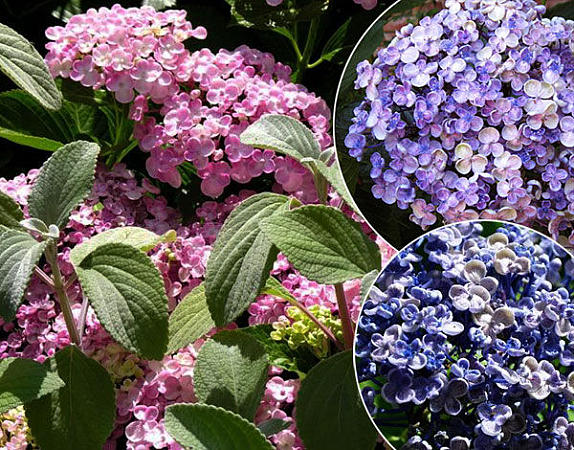 "Ayesha"
"Ayesha"
The list of varieties of winter-hardy, remontant (RE) and terry large-leaved hydrangeas is increasing: "Fireworks Pink" (pink, RE), "Fireworks White" (white, lacecap, RE), "Coco Blanc" (white terry, RE; synonym "Double Star Coco "," Triple Star Coco "," You & Me Coco ")," Shamrock "(Terry, RE)," David Ramsey "(RE)," Oak Hill "(RE)," Decatur Blue "(RE)," Penny Mac "(RE)," All Summer Beauty "(RE)," Mini Penny "(RE)," H. serrata Blue Deckler "(RE)," Let "s Dance Starlight" (RE), "Let" s Dance Moonlight "(" Robert ", RE)," Eva Lyon Holmes "(RE)," Madame Emilie Mouillere "(RE), etc.
A new era has begun for the large-leaved hydrangea with the advent of these chic winter-hardy varieties. And Russian flower growers can now purchase them for their garden. The former fashion for these plants is returning, because flowering hydrangea bushes used to traditionally decorate Russian estates!
Common varieties of large-leaved hydrangea survive cold winters only under cover. However, early autumn or late spring frosts can damage the flower buds of the bush, and then it does not bloom.
 "Tivoli"
"Tivoli"
The difference between the new varieties of large-leaved hydrangea is their ability to grow successfully and bloom regularly in gardens located in regions with frosty winters and long, cold springs. In addition to winter hardiness, these resistant varieties have another remarkable property. They are able to bloom both on last year's shoots and on the shoots of the current year. Therefore, they are called remontant (RE) or always blooming ("Everyblooming").
Large-leaved hydrangeas in our garden
Large-leaved hydrangeas "Early Sensation" have been growing in our garden for six years. And I am not overjoyed that I have the opportunity to see them bloom every year. Inflorescences on last year's and current shoots of these bushes were formed even after very severe frosts that occurred in the winter of 2005-2006, as well as 2008-2009.
Hydrangea "Red Sensation", which has burgundy branches, surprises with its unusual color of flowers. At first, its inflorescences are scarlet-red with a brilliant tint, and by autumn the flowers acquire a rich color in burgundy-pastel colors.
The exquisite large-leaved hydrangea "Peppermint" has pale pink flowers with a wide white border. The "Expression" variety flaunts large double flowers of intense pink color.
Change in color of inflorescences in large-leaved hydrangea
Like all large-leaved hydrangeas, new varieties of hydrangeas are able to change the color of their inflorescences from pink and red to bluish-blue and burgundy-purple when the acidity of the soil changes to pH values \u200b\u200bof 5.2-5.5. To do this, you can use special blue dyes, they are sold in the store in the fertilizer department. Or ordinary alum is used (alum is called crystals of metal salts, which are highly soluble in water and used to give it an acidic environment).
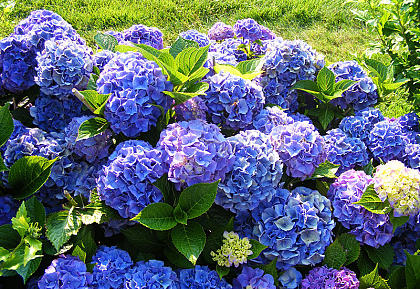 "Bodensee"
"Bodensee"
 "Twist and Shout pink"
"Twist and Shout pink"
To change the color of the flowers of large-leaved hydrangea, peat is also used: they bring it into the ground, mulch the hydrangea bush with peat, water the hydrangea with water infused with peat (it is also good as a fertilizer).
Rusty nails or pieces of rusty iron, thrown in the irrigation water for several days in advance, also contribute to the "blueing" of the hydrangea flowers. For long-lasting rust, nails can be buried in the ground near the roots of the hydrangea.
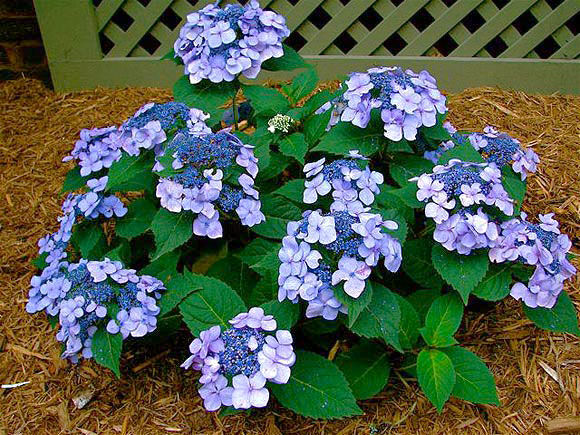 "Twist and Shout blue"
"Twist and Shout blue"
Growing large-leaved hydrangea
Caring for large-leaved hydrangeas during the garden season is mainly limited to regular watering in dry hot weather.
It is important for novice gardeners to know about the correct feeding of large-leaved hydrangeas. A mineral fertilizer that can be used when growing hydrangeas with blue-blue flowers should be low in phosphorus and high in potassium (NPK \u003d 25: 5: 30). The acidity of water for irrigation should not be higher than pH 5.6.
Reproduction of large-leaved hydrangea
Large-leaved hydrangeas reproduce well by dropping shoots, as well as by cuttings (both at home and in garden). For me, cutting hydrangeas at home in the winter, when I am free from gardening, is more suitable.
 "Renate-Steiniger"
"Renate-Steiniger"
I cover my large-leaved hydrangeas for the winter like this:
- Before the onset of frost, I huddle the bushes of hydrangeas in the shade, pouring several buckets of earth into the base of the plant bush and into the zone of its roots.
- I set low wooden boxes on the ground next to the hydrangeas.
- I put the hydrangea shoots on the boxes and pin them to the ground (through the cracks in the boxes).
- I cover the stacked hydrangeas with several layers of lutrasil, and on top with a film.
- I fix the shelter with stones so that the wind does not blow off the film.
For many years, gardeners in most of the Central European regions of Russia admired the lush bushes of garden hydrangea with envy only in the southern regions and in European gardens. Not so long ago, thanks to the efforts and perseverance of breeders from different countries and in Russian gardens, large-leaved hydrangea appeared, winter-hardy varieties of which are able to withstand our rather difficult climatic conditions and please with abundant flowering.
Dating history
Europeans owe their acquaintance with hydrangea to French travelers, who at the end of the 17th century, having sailed around the world, brought this plant from the island of Mauritius. The first version says that this beautiful flower was named after the sister of one of the expedition members, Prince Carl Heinrich of Nassau-Siegen - Princess Hortense. There is another version: this plant was named after his beloved Hortense by a naturalist and naturalist from France Philibert Commerson. There is also a completely prosaic version of the origin of the name: from the Latin word hortensis, which in translation means "from the garden", as the shrub was found in the gardens of the governor on the island of Mauritius.
Botanists named this plant hydrangea macrophylla, but the old name was also retained in another name - garden hydrangea (Hydrangea hortensis). Hydragenia is a Greek word and consists of two parts: hydor - water and angeion - vessel. Thus, it turned out that the name means "a vessel of water." Some researchers suggest that the plant got this name because of its seed pods, which are very similar to small jugs. For others, it emphasizes the hydrangea's high water requirement.
Botanical description
In nature, large-leaved hydrangea is a shrub whose height can reach 4 meters. In our northern conditions, the plant rarely exceeds two meters. This type of hydrangea is also called colored, since cultivated forms can have petals of white, pink and blue color, collected in inflorescences of a spherical and much more rarely flat thyroid form with a diameter of up to 20 cm and more.  The Avantgarde variety has appeared relatively recently, the inflorescences of which can reach 30 cm in diameter. Flowers of this type of hydrangia are simple, semi-double and double. The flower petals of this plant usually have a simple rounded shape, but there are varieties in which the petals are fringed, corrugated and serrated. It is quite rare to find varieties with a two-tone color, such as Harlequin, Love you kiss or Ripple. In addition, large-leaved hydrangea (ornamental flowers and shrubs) has:
The Avantgarde variety has appeared relatively recently, the inflorescences of which can reach 30 cm in diameter. Flowers of this type of hydrangia are simple, semi-double and double. The flower petals of this plant usually have a simple rounded shape, but there are varieties in which the petals are fringed, corrugated and serrated. It is quite rare to find varieties with a two-tone color, such as Harlequin, Love you kiss or Ripple. In addition, large-leaved hydrangea (ornamental flowers and shrubs) has:
- erect stems;
- leaves of a simple ovoid shape of bright green color;
- inflorescences of a spherical or flat shape, formed at the ends of the shoots.
Bloom lasts from July to August. In each inflorescence, two types of flowers are possible:
- fruiting and small in the center;
- external - beautiful and decorative, but sterile.
How do they handle the cold?
It should be noted that for a long time only in winter gardens and indoor floriculture there was a large-leaved hydrangea. 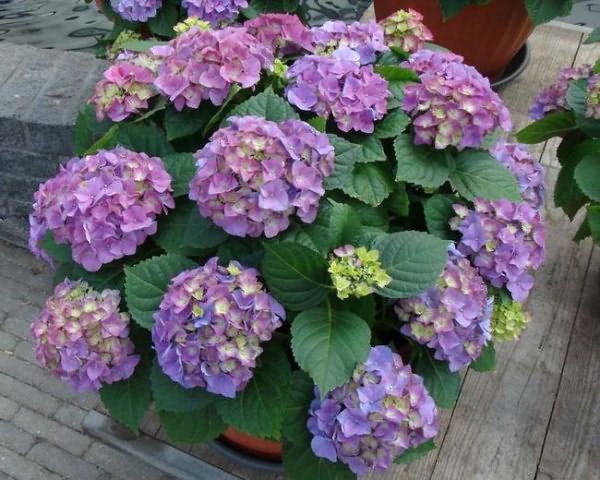 Winter-hardy varieties of this plant, the appearance of which delighted gardeners in the late 80s of the last century, differ among themselves not only in appearance, but also in the negative temperature they withstand. So, varieties of North American selection calmly tolerate temperatures up to -15 0С, and those created by European breeders - up to -20 0С. Regardless of what developers or sellers say about the variety, in the conditions of the European part of our country, it is better to shelter shrubs of this species for the winter than to survive until spring, whether they survive or not.
Winter-hardy varieties of this plant, the appearance of which delighted gardeners in the late 80s of the last century, differ among themselves not only in appearance, but also in the negative temperature they withstand. So, varieties of North American selection calmly tolerate temperatures up to -15 0С, and those created by European breeders - up to -20 0С. Regardless of what developers or sellers say about the variety, in the conditions of the European part of our country, it is better to shelter shrubs of this species for the winter than to survive until spring, whether they survive or not.
Resistance of varieties
As practice has shown, all winter-hardy varieties of large-leaved hydrangea can, of course, conditionally, be subdivided into the following groups:
1. Blooming on last year's shoots: Mariesii Grandiflora (White Wave), Mariesii Perfecta (BlueWawe), Alpengluehn, Bouquet Rose, Red Baron (Schoene Bautznerin), Lilacina, Etoile Violette and others.
2. Eternal flowering or remontant. In contrast to the first group, they form inflorescences on both last year's and new shoots. These include such winter-hardy remontant large-leaved hydrangea varieties such as Grant`s Choice, for example, as well as Twist-n-Shout, Pink Wonder, Hamburg, Passion.
When buying varieties of this group, you will definitely find Persistence, Everyblooming or Re-blooming (RE) on the labels.
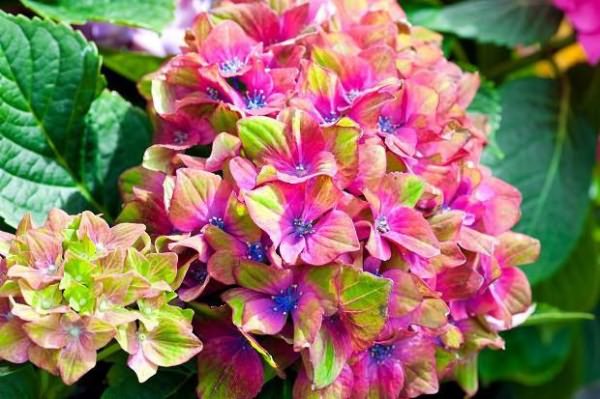
Varieties and series
By the end of the 80s of the XX century, the first winter-hardy varieties of large-leaved hydrangea appeared in America, capable of growing and blooming in regions with cold winters and lingering, cold springs. One of the “first-borns” of remontant hydrangeas was the Endless Summer variety - Endless Summer. Somewhat later, a more frost-resistant variety Early Sensation was introduced to the market than Endless Summer.
Endless Summer Series
Endless summer is a large-leaved hydrangea. Winter-hardy varieties based on it were obtained with various colors and made up the Endless Summer variety group:
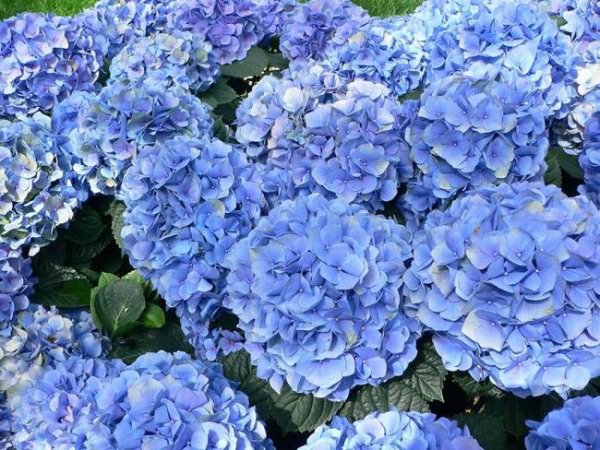
All varieties have voluminous and beautiful, round inflorescences, with the exception of Twist-and-Shout, which is flat.
Forever & Ever
Over time, the commercially successful Forever & Ever series was created on the basis of the Early Sensation variety, which includes varieties:
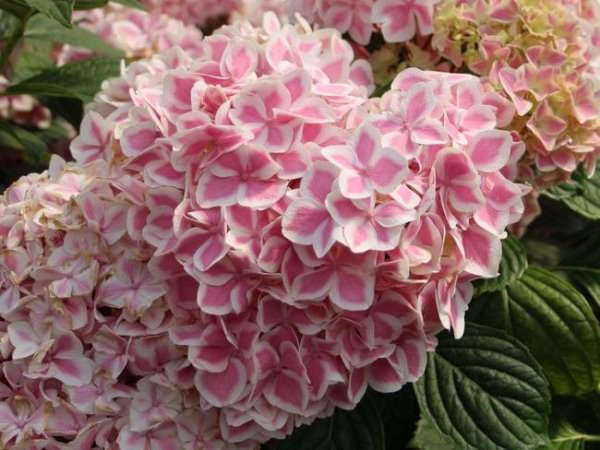
The series must be indicated on the labels before the name of the variety, for example, Forever & Ever Red Sensation.
You & Me Series
Those who prefer terry large-leaved hydrangea, frost-resistant varieties can be found in the Japanese You & Me series:
- Together;
- Romance;
- Expression;
- Forever;
- Symphony;
- Eternity;
- Love is a pink novelty for 2015.
Large-leaved hydrangea: an overview of new varieties
Every year the number of remontant winter-hardy varieties of large-leaved hydrangea increases. Let's talk about some new products.
Endless Summer Bloom Star was created on the basis of the so beloved variety of Endless Summer. This hydrangea blooms with large globular inflorescences of blue or pink colour, the diameter of which can reach 18 cm. The color of sterile flowers depends on the acidity of the soil: in more alkaline colors it will be pink, and in acidic ones - violet-blue. Not only inflorescences are decorative, but also burgundy shoots.
Hovaria Hanabi Rose blooms with large, flat inflorescences 18-25 cm in size. The flowers are double, light pink, but if the soil is acidified, they change color to blue.
You & Me Love is a novelty of this year with delicate pink and double flowers, the inner petals of which are painted in a creamy yellow shade. The color may vary depending on the acidity of the soil. 
Endless Summer Blushing Bride is a very interesting variety with discoloration of the petals. The buds of this hydrangea open into semi-double white flowers, which are gradually tinted with a slight pink "blush".
Avantgarde is not a new variety, but still quite rare in our gardens. The huge size of globular and dense inflorescences up to 30 cm in diameter is what distinguishes this large-leaved hydrangea from others. Winter-hardy varieties with such large "caps", and even represented by five colors - green, white, blue, lilac and pink - have not yet been created.
Cover or not?
Most gardeners, having read that, in our conditions, large-leaved hydrangea (frost-resistant varieties) does not need shelter for the winter, a serious discussion was launched both on the Internet and on the pages of magazines. But practice, as is usually the case, put everything in its place.  If the gardener wants to enjoy flowering from the beginning of summer until frost, then, of course, it is worth covering. In the event that a not very long and abundant flowering from mid-summer to autumn will please you, then you can not cover it. Many who have bought large-leaved hydrangea seedlings are perplexed: "How is it, it is written that it hibernates without shelter, but experts say the opposite?" The fact is that the buds of last year, which were not protected from negative winter temperatures, will die, but new shoots, before they form inflorescences and bloom, must still grow. Therefore, before purchasing this truly beautiful plant, think about whether you can create the most favorable conditions for it.
If the gardener wants to enjoy flowering from the beginning of summer until frost, then, of course, it is worth covering. In the event that a not very long and abundant flowering from mid-summer to autumn will please you, then you can not cover it. Many who have bought large-leaved hydrangea seedlings are perplexed: "How is it, it is written that it hibernates without shelter, but experts say the opposite?" The fact is that the buds of last year, which were not protected from negative winter temperatures, will die, but new shoots, before they form inflorescences and bloom, must still grow. Therefore, before purchasing this truly beautiful plant, think about whether you can create the most favorable conditions for it.
How to properly prepare for winter?
IN middle lane Russia should start preparing large-leaved hydrangea for winter in September. The condition for a good wintering of the bush will be low humidity. In order to prevent moisture from getting on the plant, a frame is erected above it and covered with a film on top. Special furrows are dug around the hydrangea to drain water and, accordingly, watering is stopped. In early October, the faded inflorescences, all the foliage, together with the petioles, are removed. In the center of the bush, experts advise, it is best to pour garden soil or peat, you can mix. The stems are tied and laid on low wooden boards, boxes or beams. From above, the entire structure is closed with several layers of covering material, for example, lutrasil. The tips of the shoots can also be sprinkled with peat-soil mixture or sawdust, after which the entire plant is covered with a dense plastic wrap.
First, let us once again draw your attention to the fact that when choosing one or another variety, first of all, look at how adapted it is to our climatic conditions and is resistant to diseases. You may need to know some of the features of growing large-leaved hydrangea in the garden:
- it is advisable to plant plants in loose soil, thanks to which it wakes up faster in spring;
- plant a plant in an elevated area, since with low humidity it winters better;
- before sheltering the bush for the winter, it is imperative to saturate the earthen lump of hydrangea with water and feed it with potash and phosphorus fertilizers;
- do not rush to remove the shelter in the spring, as this shrub is hard to tolerate return spring frosts, more difficult than winter frosts;
- after the spring cold has passed, do not immediately remove the spunbond or lutrasil covering the hydrangea, because the bright sun can burn the delicate shoots.
fb.ru
Garden hydrangeas: an overview of the best varieties
Many interesting plants have appeared in our gardens in recent years. And the varietal variety of seedlings offered by nurseries is amazing! It is also important for Russian gardeners that the purchased plants have high winter hardiness.
So, hydrangea, which some time ago was considered a capricious plant, now occupies a confident place in garden plots... On sale there is a wide variety of types and varieties of hydrangea, which is the favorite of many gardeners.
Consider a contemporary assortment of wonderful hydrangeas different types.
Hydrangea
Treelike hydrangea is considered the most unpretentious and persistent, so let's start our review of the species with it. Tree hydrangea is represented by a small number of varieties, but this hardy species can be recommended even for novice gardeners.
The most widespread variety of tree hydrangea is Annabel, which is distinguished by powerful domed bushes up to 1.5-2 meters high. In early July, this wonderful plant is abundantly covered with large caps of snow-white globular inflorescences of sterile flowers, which remain on the shoots until the end of the season. During the flowering period, the Annabelle hydrangea is a spectacular sight. Beautiful inflorescences can be cut and used in winter bouquets. Before wintering, this hydrangea does not need shelter, it hibernates quite well in natural conditions. In the fall, you just need to cut off the faded inflorescences and carry out sanitary pruning.
On sale now you can find others, incl. new varieties of hydrangea tree-like: - "Bella Anna" - large spherical large inflorescences, their color from magenta - pink to purple-pink; - "Grandiflora" - with huge snow-white inflorescences; - "Invisibel Spirit" - with pink inflorescences; - "Incredible" - with large snow-white inflorescences of sterile flowers; - "Pink Picash" - with pink inflorescences; - "Sterilis" - with snow-white inflorescences of sterile flowers; - "White House" - has a corymbose inflorescence with sterile flowers along the edge of the inflorescence and fertile (fruiting) in the center. These and other varieties of tree hydrangea undoubtedly deserve close attention, especially for novice gardeners.
In the photo: Bella Anna tree hydrangea; hydrangea tree "Incredible"
Hydrangea paniculata
Hydrangea paniculata - is also a very attractive and rather frost-resistant species (the degree of frost resistance may vary by variety). But even if the plant freezes, the bush will quickly recover and bloom on the shoots of the current year. Its inflorescence is a panicle, which distinguishes the panicle hydrangea from the tree-like one, which has a spherical inflorescence.
Inflorescences panicle hydrangea stay on the plant for a long time, they can gradually change color. Cut inflorescences keep well in winter bouquets. The plant also overwinters without shelter (in a place protected from cold winds, if there is sufficient snow cover), or under light shelter.
Panicle hydrangea has numerous and varied varieties, differing in the size of the bush, the structure and color of the inflorescences, and the timing of flowering. For example, the following varieties have already become fond of gardeners and have become widespread: - "Grandiflora" - has classic large white inflorescences that turn pink over time; - "Limelight" - late-flowering variety with huge pale lemon inflorescences; - "Vanilla Fries" - unsurpassed hydrangea with delicate, incredibly beautiful white-pink inflorescences; - "Kiushu" - with white, pinkish inflorescences of sterile and fertile flowers, early flowering; - "Pinky Winky" - pink-red inflorescences with a predominance of sterile flowers and the presence of fertile ones.
In the photo: panicle hydrangea "Limelight", panicle hydrangea "Vanilla Fries"
A wide variety of varieties of panicle hydrangea are found in our gardens due to the resistance of this plant in the middle lane. A rich palette of inflorescence colors, a high decorative effect have made this fascinating plant a favorite of many gardeners. For example, you can single out a whole series of "magic" varieties of panicle hydrangea, which will decorate the garden with magnificent inflorescences of various colors: - "Medical Candle" - white, turning pink; - "Medical Moonlight" - has classic white inflorescences; - "Medical Starlight" - white inflorescences of graceful sterile and fertile flowers; - "Medical Fire" - is distinguished by bright red inflorescences of sterile and fertile flowers; - "Medical Flame" - inflorescences are creamy white at first, then burgundy-red and at the end of flowering purple-pink.
Along with the already well-known and beloved varieties, the panicle hydrangea often has interesting novelties - the varietal variety of available varieties is quite large, for example: - "Bobo" - a dwarf form with pale pink inflorescences; - "Bomshell" - a dwarf form with white inflorescences; - "Brussels Leys" - has very large ivory inflorescences, sterile and fertile flowers; - "Weems Red" - features a very large inflorescence up to 30-35 cm long with a charming honey aroma (!), Blooms in three colors; - "Great Star" - flowers consist of two types: large with elongated petals in the form of a "propeller" with a diameter of about 5 cm and small fertile flowers white; - "Darts Little Dot" - dwarf hydrangea about 1 m tall with pink corymbose inflorescences; marginal flowers are sterile, central fertile; - "Diamant Rouge" - large fertile flowers open pure white, turn pink within two weeks, and by the end of July acquire a rich cherry-red color in full dissolution, has the most intense red color among paniculate hydrangeas; « - Last Post "- huge sterile white flowers accentuated by a mass of purple-pink fertile flowers; - "Levana" - has a white-pink inflorescence, reminiscent of a chestnut blossom; - "Matilda" - large flowers, when blooming, creamy white, then turn white, then turn pink, and when blooming, they become greenish-red; - "Mega Mindi" - white flowers acquire a dark pink color by the end of summer; - "Pink Diamond" - its inflorescences up to 30 cm long consist of fertile and sterile flowers, and the color of the flowers is creamy white at first, then it becomes dark pink, almost red; - "Precox" - has white corymbose inflorescences of sterile and fertile flowers; - "Sand Fries" - inflorescences of sterile flowers are initially white, then become crimson; - "Silve Dollar" - large white inflorescences turn pink by autumn; - "Tardiva" - late-flowering, cone-shaped creamy white inflorescences consist of sterile and fruiting flowers; - "White Lady" - has white cone-shaped inflorescences of sterile and fruiting flowers; - "Phantom" - large apical panicle inflorescences at first creamy white, turning pink by autumn; - "Floribunda" - distinguished by very large rounded sterile flowers on long stalks; - "Harris Souvenir" - white inflorescences with a slight pink tint; - "Angel Blush" - flowers are initially white, then pink, in autumn - red, consist of sterile and fertile flowers; - "Earley Sensation" - large racemose inflorescences consist of pink sterile and fertile flowers; - "Unique" - white flowers are collected in large inflorescences with a diameter of 25 cm, when flowering, they turn pink.
Large-leaved hydrangea
Large-leaved hydrangea is very beautiful and popular, but unlike the other two species, it requires special attention in the garden. Large-leaved hydrangeas of many varieties bloom for a very long time, have beautiful rounded inflorescences of various colors (it changes depending on the acidity of the soil).
The large-leaved hydrangea has become widespread thanks to the widespread sale of potted hydrangeas in flower shops and supermarkets. But the plants presented there are mostly not frost-hardy enough, therefore, at the household level, all hydrangeas were fixed misconception about their non-immunity ... In addition, hydrangeas from flower shops are usually beautiful only this year. After planting in the garden, they usually stop blooming, because their flowering occurs on the shoots of the last year, which freeze due to insufficient winter hardiness. At the same time, the plant survives, but the newly growing shoots do not bloom in the first year, and in winter they freeze again. Because of this, such a plant, although it releases regularly shoots, does not bloom. Therefore, large-leaved hydrangeas bought in the store are most often used as a gift "bouquet in a pot".
Until recently, only a few experienced Russian gardeners managed to find suitable places for large-leaved hydrangeas in the garden and provide proper care, which allows plants to winter well and bloom annually. However, with the advent of new unique varieties of large-leaved garden hydrangea, it became possible to actively promote them in the gardens of the middle lane. These new large-leaved hydrangeas are characterized by increased winter hardiness and are able to bloom on the shoots of the current year, therefore, even when the branches freeze, the plants bloom on the newly growing shoots. It is also desirable to cover these hydrangeas for the winter, but the likelihood of their preservation in the winter and further flowering is much higher.
Now on sale there are whole series of frost-resistant varieties of large-leaved hydrangea, which bloom on the shoots of the current year, for example: - the Endless Summer series (Endless Summer) with the Blushing Bride, Original, Twist and Shout varieties (with sterile and fertile flowers), etc.; - a series of "Forever and Ever" with varieties of various colors; - series "U-and-Mi" with varieties "Forever", "Romance", "Eternity", "Expression", "Tugese", "Symphony", etc.
In the photo: large-leaved hydrangea "Red Sensation"; large-leaved hydrangea "Mini Penny"
For Russian gardeners, winter-hardy remontant varieties of large-leaved hydrangea blooming on the shoots of the current year are of particular interest: Earle Sense, Blue Haven, White Ball, Red Sense, Peppermint, Firewax Pink, Firewax White "," Coco Blank "," Shamrock "," David Ramsay "," Oak Hill "," Decatur Blue "," Penny Mac "," All Summer Beauty "," Mini Penny "," Years "with Dance Starlight", Years with Dance Moonlight, Eva Lion Holmes, Madame Emily Muiller, Ripple, Hobergin, etc. To avoid disappointment and decorate your garden for many years, these new large-leaved hydrangeas with a confirmed name and full characteristic of the variety is best purchased in a reliable nursery.
Ground cover hydrangea, or Himalayan
Ground cover hydrangea is still less common, but it is of undoubted interest for novice gardeners, suitable for gardens with minimal maintenance. Winter hardiness of the Himalayan hydrangea is high; because of its unpretentiousness, it is also recommended for urban landscaping.
Now more and more often you can find Himalayan hydrangea (Bretschneider) on sale. Despite the fact that this hydrangea is called a ground cover, it is a large shrub 2.5-3 meters high with milky white flowers. Sterile flowers are greenish after opening, then become milky white, and later acquire a purple hue. Large, umbellate, slightly convex inflorescence shields consist of 400-500 fertile and about 20 sterile marginal flowers that last for a very long time.
After cutting and drying, the inflorescences of ground cover hydrangea can be used in dry bouquets throughout the winter. And the Himalayan hydrangea blooms profusely and annually, in June-August.
Hydrangea oakleaf
Oak-leaved hydrangea is a very interesting, but not hardy species. The decorative effect of this species is created not only by inflorescences, but also by unusual leaves. Therefore, even after freezing, overgrowing plants are decorative.
To plant a seedling of oakleaf hydrangea in Russian gardens, you need to choose protected places, and for the winter to shelter the bush from frost.
In the photo: oak-leaved hydrangea; petiolate hydrangea
Hydrangea petiolate, or curly
Stalked hydrangea is a slow-growing liana with lignified shoots. It can be grown both on a trellis and as a ground cover crop. With its aerial roots and suckers, the petiole hydrangea attaches to the support and is able to rise to a height of more than 20 meters. This wonderful plant is used to decorate walls, arbors, arches and tree trunks. If there is no support, then the stem of the petioled hydrangea spreads; climbing hydrangea can look like a bush up to 2 meters high.
The petiole hydrangea has beautiful corymbose inflorescences, consisting of sterile and fertile flowers. This unusual type of hydrangea is winter-hardy. It is important that the plant safely tolerates the winters of the middle lane and does not need additional shelter,
In addition to the plants named in the overview, there are also other attractive hydrangea species. However, they are less hardy and need sheltered conditions. Therefore, in the middle lane, thermophilic hydrangea species have not become widespread, they are successfully grown only in the southern regions.
The advantages of hydrangeas and their content in the garden
Blooming hydrangeas create a festive atmosphere. Even a single hydrangea bush will be a bright and spectacular garden decoration in the summer months and autumn. The undoubted advantage of garden hydrangeas is the ability to grow in partial shade. Therefore, hydrangea bushes can decorate not only open spaces where many other plants grow and bloom well, but also a semi-shady garden, where it is much more difficult to find an assortment of suitable flowering plants.
Another advantage of hydrangeas is the long flowering period. They still continue to bloom when most of the garden shrubs have already faded. The change in color of hydrangea inflorescences as it blooms is very interesting, and also pleases the possibility of using cut inflorescences in winter bouquets. All these numerous advantages make the hydrangea a unique plant for the duration of the decorative effect in the garden and at home.
In late spring and early summer, garden hydrangeas attract everyone's attention with their very large toothed leaves. From the second half of summer, the magic of hydrangea bloom begins. Until late autumn, the garden is decorated with lush hydrangeas - white, pink, blue, red, purple caps and pyramids of their inflorescences.
Hydrangeas grow better on humus-rich, loose and moist soils. Hydrangeas do not withstand calcareous soils, but they develop quite successfully on well-drained soils with a low lime content. Hydrangeas grow and bloom well on acidic and moist soils, peat or sandy. In areas with summer droughts, hydrangeas need watering, otherwise these plants do not feel well and winter worse.
In order to get good growth and large inflorescences, in addition to choosing the right place for planting and providing the hydrangea seedling with moisture and the necessary nutrients during its growth, a strong pruning of the plant is necessary in autumn or early spring. Garden hydrangeas in today's varietal variety are a wonderful sight!
Since ancient times, beautiful hydrangeas have been considered a traditional plant in the Russian garden, and have also been grown in gardens in many countries of the world. Undoubtedly, both now and in the future, modern hydrangeas of various species and varieties deserve to take their place of honor in gardens and parks.
Ordering the best varieties of hydrangeas in the Yuzhny nursery
The Ornamental Crops Nursery "Yuzhny" - a member of the Association of Planting Material Producers - brings to your attention the Hydrangea Catalog. Our extensive collection of hydrangeas now includes over 60 the best varieties different types for all tastes, suitable for gardens of all sizes and styles. At your service - retail and wholesale of plants at competitive prices.
In the Hydrangea Catalog you will get acquainted with a description of popular types of hydrangeas and a detailed description of all the varieties of hydrangeas available for sale, and you can also study the features of caring for them.
Order the varieties of hydrangeas you like, and if necessary, contact the specialists of the Yuzhny nursery for advice. We hope that the quality and price of the seedlings will delight gardeners, and the purchase of the desired plants in the nursery will be successful.
Winter-hardy hydrangeas will wonderfully decorate your garden, bring a lot of joy to your family with long and spectacular flowering!
Andrey Nagaytsev (Candidate of Agricultural Sciences, agronomist of the Yuzhny nursery) OOO Yuzhny Ornamental Culture Nursery Moscow region, Serpukhov district, village Starye Kuzmenki tel. +7 495 769-16-20
gardenia.ru
Hydrangea tree varieties, planting and care, as well as their diseases: photo
Origin
Hydrangea (Hydrángea) grows in the South and East Asia, North and South America, you can find its greatest variety in East Asia, namely in China and Japan.
It is easy to grow varieties of hydrangeas due to their unpretentiousness to climate conditions. Even if you are going to plant it in the harsh climate of Siberia, it will take root perfectly.
You can find about 80 types of hydrangeas. They can be shrubs, trees, and even lianas. The flowers are of different colors - white, pink, red, blue and blue.
Tree hydrangea - the most common and unpretentious type of hydrangea
Treelike hydrangea (Hydrangea arborescens) is the most common and unpretentious type of hydrangea that can withstand the harsh winter climate. If you are new to gardening, then of all types of hydrangeas, we suggest starting with the cultivation of this type.
The tree can reach up to 3 m in height and will delight you with its appearance from June to October. This type of hydrangea is native to North America.
White inflorescences are more common, which turn green over time, they grow, taking the shape of a ball.
Treelike hydrangea varieties
Annabelle (Hydrangea arborescens Annabella) - this variety of hydrangea tree-like reaches a height of up to 1.5 m, but the crown of the shrub reaches a diameter of 3 m. The leaves of a bright green color 8-15 cm long remain green until late autumn.
Annabelle
White flowers about 2 cm in diameter are collected in inflorescences up to 25 cm in diameter. From June to September, you will admire this variety. It is the tree hydrangea Annabel that grows rapidly. For a year, the growth is 20 cm.
Grandiflora (Hydrangea arborescens Grandiflora) - shrub reaches a height of up to 2 m, the crown is the same as that of the Annabelle variety, i.e. up to 3 m in diameter. Light green leaves grow up to 16 cm long.
Grandiflora
Unlike the pure white flowers of the tree-like Annabelle hydrangea, the flowers of Grandiflora are creamy white, up to 2 cm in diameter, they are collected in inflorescences up to 20 cm in diameter. Differs in abundant and long flowering from June to September.
Sterilis (Hydrangea arborescens Sterilis) - this variety has a longer flowering time than others, you can admire the inflorescences from July to October. Thick and heavy inflorescences bend the branches. The inflorescences are made of whitish-green flowers that become pure white over time.
Sterilis
Invisibel Spirit (Hydrangea arborescens Invincibelle Spirit) - also known as the tree-like pink hydrangea. As you guessed, the flowers of this variety are pink. Over time, the color can change from light pink to deep pink. The leaves are dark green, turning yellow by autumn. It will bloom from June until the very frost.
Invisibel Spirit
Planting and leaving
Before you run to the store for seedlings, you need to figure out how to properly plant and further care for the tree hydrangea.
As we have already said, this plant is unpretentious and can tolerate a harsh climate, but it is worth noting that the tree hydrangea is moisture-loving and does not tolerate direct sunlight, it is also undesirable for the place for the future hydrangea to be windy. Therefore, your first step in growing a tree hydrangea is to find a suitable place in your garden, the conditions of which will favorably affect its growth.
As for purchasing advice, it is best to buy hydrangea seedlings in a tree-like spring when the buds are still closed.
The next step is to dig a hole 50 cm in diameter and 65–75 cm deep. We repeat that it is better to plant a plant in the middle of spring, somewhere in the beginning of April. Next, we place the stalk in a hole and fill it with a pre-prepared mixture of humus, black soil, peat and sand in a ratio of 2: 2: 1: 1 with an admixture of urea (15–20 g) and 30 g of potassium sulfate and superphosphate each. Repeat this top dressing every 2 years.
The distance between plants should be 1.5 meters
It is important to note that the plant must be planted at a distance of 1.5 meters from each other, and it is also not advisable to plant a tree hydrangea next to trees due to the absorption of a large amount of moisture.
After planting the cuttings of this plant, you will be able to admire the flowers only for 4–5 years. It is not necessary to close the plant for the winter, even it will freeze, it will recover due to the powerful root system.
Feeding the plant with mineral fertilizers or manure is carried out at the beginning of growth and when the inflorescences appear. Also, if you wish, you can fertilize the soil in summer time smaller doses once or twice.
Appearance support
As you understand, planting a plant is not enough, you still need to be able to take care of it in order for it to please you as long as possible. Let's try to consider the special points of pruning a hydrangea tree.
The most important note is that you do not need to prune a young plant, pruning is carried out for 3-4 years of life. Let us explain why this should not be done. In the first years of life, the hydrangea tree-like in springtime has very abundant sap flow, therefore, if you cut it, it will immediately die and, unfortunately, it will not be possible to restore it.
Don't forget to prune the plant
Treelike hydrangeas over 4 years old can be pruned in early spring. In order for the shrub to improve flowering and the plant becomes thicker, it is necessary to cut off 10–20 cm from the ends of the branches.
There are several stages of pruning:
- The very first stage, the so-called "sanitary", includes inspecting the plant and removing frozen and broken branches.
- Rejuvenating pruning - suitable for adult plants, its purpose is to "rejuvenate" the shrub, as over the years the inflorescences may lose their splendor. And this happens due to the fact that old shoots prevent the development of new stems, consuming a large number of nutrients.
- The stage of formation includes pruning last year's shoots to 2–4 pairs of strong buds.
- Thinning pruning involves removing small shoots that waste nutrients and thicken the bush.
Reproduction
If over time you not only want to admire the plant in your garden, but also please your friends or family, teach them how to plant a tree hydrangea and take care of it, you should definitely know how this type of plant reproduces.
Treelike hydrangea propagates vegetatively, namely by cuttings and layering.
Reproduction of hydrangea
When your bush blooms, you will need to cut green cuttings (exactly green, because lignified ones simply will not grow) and plant them, as we explained earlier. Also, if you process them with special means (like, for example, "Kornevin"), they will take root without any problems.
Diseases and pests
Like any plant, the tree hydrangea can undergo some changes due to various diseases and pests. Let's try to figure out what can cause hydrangea tree disease and how to deal with it. Here is a list of the most common pests and diseases:
- Spider mite. If you notice yellowing and a marbled color on the underside of the leaf, then you are faced with a spider mite. In the future, these leaves will dry out and fall off. It can divorce and develop at temperatures of 29–31 ° C and humidity of 35–55%. At low temperatures (10–12 ° С) and high humidity (80–85%), its activity is significantly reduced. What to do in this case? It is necessary to spray the leaves with thiophos (5–7 g per 10 l of water).
- Downy mildew. In this case, leaves and stems are affected. Oily, yellowing spots appear on the leaves, which later darken and increase. The bottom of the leaves is covered with a yellow bloom, and yellow bloom can also be on young stems. The temperature of 18–20 ° C and high air humidity contribute to the development of the disease. In this case, you can treat the plant with a copper soap liquid (150 g of green soap, 15 g copper sulfate 10 liters of water) - this mixture is completely harmless to plants and will help get rid of the disease.
- Chlorosis. In case the leaves become lighter and the veins are dark, then you are faced with chlorosis. Usually plants that grow on soils with a large amount of lime are exposed to this disease, and an excess of humus in the soil can also contribute to this disease. In order to get rid of chlorosis, it is necessary to pour several times (2-3) with a solution of potassium nitrate (40 g per 10 l of water), and three days later - with a solution of ferrous sulfate in the same amount as potassium nitrate.
- Green leaf aphid. The plant is affected by aphids in indoor conditions when forcing plants. Anabasine sulfate solution is an excellent remedy for the destruction of aphids. It is necessary to dissolve 15–20 g of anabazine sulfate in 10 liters of water. You need to spray twice.
To summarize briefly:
- Treelike hydrangea is great for decorative purposes, will decorate your garden, usually used as hedges.
- Propagated by cuttings.
- It is best to buy seedlings in the spring, when the buds are closed.
- You need to plant seedlings at a distance of 1.5 m from each other.
- The plant is hygrophilous, so it must be watered often and abundantly.
- Pruning the plant is necessary to maintain its appearance. This is best done at 3-4 years of flowering.
Among all the typical and bright representatives of the glorious family of hydrangea, there are also especially luxurious specimens. About one of the varieties of such indoor and garden plants we will tell you today. You will receive detailed information about the culture - description of the species, characteristics of cultivation, conditions of detention.
To enjoy the globular Nikko Blue inflorescences all summer long, it is worth placing such a plant on your windowsill. Moving on to the description of the culture. Large-leaved hydrangea is a shrub that reaches a maximum of one and a half meters in height.
It has bright green foliage, green and herbaceous shoots, which are capable of woody and cracking only in the next season. The Nikko Blue variety is characterized by large, rounded flowers that change color from white to blue. Their color depends on the reaction of the soil used. To preserve the rich blue hue of the flowers, it is enough that the acidity of the soil is at around 5, 5 - 7, 0 Ph. If the medium is neutral, the flowers of the large-leaved hydrangea can turn pink. Flowering in the Niko Blue variety can occur on last year's and existing shoots. Large-leaved hydrangea of \u200b\u200bthis species pleases with lush flowering from June to the end of summer.
Growing
Planting of Blue hydrangea is carried out in a soil mixture with the following composition - peat, sand, leafy humus earth (in a ratio of 1: 1: 2: 2). To plant a flower, you should take fertile and moist soil. In the open ground, planting is carried out in pits located at a distance of 1 meter from each other and measuring 30 by 30 by 30 cm. One third of a bucket of humus and peat is introduced into each hole. Then hydrangeas need watering with soft rainwater. Fertilization is carried out in late May - early June.
A solution of slurry 1:10 and mineral fertilizer are taken. This top dressing consists of 10 grams of ammonium and potassium nitrate, 20 grams of superphosphate per 10 liters of water. Fertilize again after 10 - 15 days. Then the culture this year will bloom better, and there will be a normal laying of flower buds for the next season. It is necessary to mulch the trunks of the Niko Blue bushes with peat or humus.
In autumn, the bushes require hilling - the height of the earth is up to 30 cm. When growing such a large-leaved crop, they create partial shade and provide abundant watering, starting in spring. Leaves prefer periodic spraying. A plant of this species has a weak cold resistance - build a shelter for it during the winter.
Video "Large-leaved hydrangea"
Plant care
Flower care is a mandatory fertilization with the arrival of spring. Use a mixture of dressings of 25 g of urea, 40 g of superphosphate and 35 g of potassium sulfate per 1 square meter. With the beginning of bud formation, up to 80 g of superphosphate and 45 g of potassium sulfate are introduced. In the summer, 2 more dressings are carried out. Caring for such a large-leaved crop includes watering up to 20 liters of liquid under each bush.
If it rains heavily, you can water the flower once a month instead of once a week. Loosening is carried out to a depth of 5 cm together with weeding. Mulch from peat or sawdust is left for the summer. Pruning is only necessary for young bushes for cosmetic purposes. Adults without it, with normal care, will form many flowering growths. Inflorescences do not need to be cut in autumn; they are removed only in spring.
Conditions of detention
Hydrangeas of large-leaved Niko are advised to take a place where there is a small shadow, or in the sun, which will not be blown by the winds. You cannot plant a bush under the crowns of trees - they will absorb almost all the water, and your beauty will not have enough. The place is chosen so that moisture does not accumulate on the site. The soil for planting needs nutritious, loose structure, moderately moist.
Once such a plant was grown only in indoor conditions. Keeping it in open areas became possible with the development of varieties that can withstand low temperatures. With the arrival of the first frost, care involves bringing the bush to the terrace or into the room, since November it has been kept in the basement, sometimes moisturizing. There comes a dormant time, the plant sheds its leaves. In February, place it on a windowsill, water and spray. In May, an inflorescence will appear, it will be possible to take the culture out to the garden.
If the leaves turn yellow, your plant has undergone chlorosis. The soil needs to be acidified - fed with a solution of potassium nitrate, iron, iron vitriol. The presence of a spider mite is determined by the characteristic cobweb, drying and flying of foliage. Spraying with Actellik will help. A signal of a plant disease with downy mildew will be oily yellow spots on the surface of the leaves. Spray with special fungicides or products that contain copper.
Video "All about hydrangea"
In the section of the TV program "Good Time" you will learn what a hydrangea flower is, how to care for it, carry out a transplant and everything that can be useful for both a novice gardener and an experienced one.

